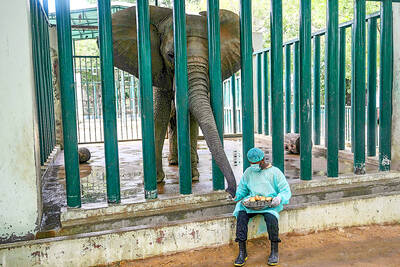The valley is nestled in the green Himalayan foothills, a wedge of cultivated land where the scenery is so idyllic and the wheat and highland barley grow so high that it is easy to overlook the tiny man sitting by the road with a black pig on his lap.
His name is Gyampa, and when he props up his stunted body with a cane, he stands maybe 1.2m tall. He is bent at odd angles, his wrists knotted and his elbows swollen the size of lemons. He is not agile or strong enough to control the pig, so he has roped it around the waist and staked it to the ground.
He has what people in this tiny village simply call "the pain," known to medical researchers as Kashin-Beck disease, or Big Bone disease. Nor is he alone. Nearly everyone in the village, including the children who happily show off their swollen elbows, either suffers from or has been exposed to the disease. The situation is so bad that in October the government is planning to move everyone away.
"There is an illness in this ground," said Trakock, 39, a villager who like many Tibetans uses only one name, and whose sister, Trasel, suffers from the disease.
Throughout Tibet, where much of the population lives in villages largely disconnected from the modern world, Big Bone disease is a severe problem, infecting roughly 9 percent of the population. In the most severe cases, the disease can cause the long bones in the arms and legs to stop growing during childhood, as was the case with Gyampa.
Researchers believe that the soil near villages like Boronggang is infected with a fungus that contributes to Big Bone disease. Scientists have yet to discover a cure, but they believe that bad water, poor diet and crops grown in mineral-deficient soil are also at least partly to blame.
"It's really a disease of poverty," said Francoise Begaux, who worked with villagers for five years as part of a research project sponsored by Doctors Without Borders, and who now works for another aid group, Terma Foundation. "It's the people who can't afford to have different kinds of food."
The problem is compounded, Begaux and other researchers say, because Kashin-Beck is largely forgotten. The disease has been eradicated or brought under control nearly everywhere except China. Within China, it is particularly acute in Tibet, one of the poorest regions. Yet last year Doctors Without Borders halted their Tibet project because of budget restraints.
So late last summer, the physicians and researchers who had been visiting Boronggang about twice a week stopped coming. They did leave gifts: a new grain thresher to help dry the wheat and barley and, in the process, reduce risks of contamination; fungicide to treat the fields and a final shipment of the iodine and selenium that had been used to offset mineral deficiencies in the children. Those medicines have since run out.
"I don't take any medicine anymore because the doctors are not here anymore," said Tenzen Pungtsock, a 15-year-old boy, whose elbow is knobby, but who seems to have a milder form of the disease.
The children today at least have a better understanding of why so many people are sick. When he was a child, Gyampa, 61, knew only that he stopped growing, not why. In medical terms, the growth cartilage in his arms and legs developed necrosis and stunted his growth. With age, his joints have weakened with arthritis, so that now he earns money by mending clothes. He is too weak to do farm work.
Chinese officials boast that farmers and herdsmen in rural Tibet enjoy free health care, but Gyampa said he never saw a doctor until about a decade ago, when the first Western physicians arrived in the village. Now that the Western doctors have stopping coming, he takes Tibetan medicine for the pain that regularly flares in his hips and joints.

NO EXCUSES: Marcos said his administration was acting on voters’ demands, but an academic said the move was emotionally motivated after a poor midterm showing Philippine President Ferdinand Marcos Jr yesterday sought the resignation of all his Cabinet secretaries, in a move seen as an attempt to reset the political agenda and assert his authority over the second half of his single six-year term. The order came after the president’s allies failed to win a majority of Senate seats contested in the 12 polls on Monday last week, leaving Marcos facing a divided political and legislative landscape that could thwart his attempts to have an ally succeed him in 2028. “He’s talking to the people, trying to salvage whatever political capital he has left. I think it’s

Polish presidential candidates offered different visions of Poland and its relations with Ukraine in a televised debate ahead of next week’s run-off, which remains on a knife-edge. During a head-to-head debate lasting two hours, centrist Warsaw Mayor Rafal Trzaskowski, from Polish Prime Minister Donald Tusk’s governing pro-European coalition, faced the Eurosceptic historian Karol Nawrocki, backed by the right-wing populist Law and Justice party (PiS). The two candidates, who qualified for the second round after coming in the top two places in the first vote on Sunday last week, clashed over Poland’s relations with Ukraine, EU policy and the track records of their

UNSCHEDULED VISIT: ‘It’s a very bulky new neighbor, but it will soon go away,’ said Johan Helberg of the 135m container ship that run aground near his house A man in Norway awoke early on Thursday to discover a huge container ship had run aground a stone’s throw from his fjord-side house — and he had slept through the commotion. For an as-yet unknown reason, the 135m NCL Salten sailed up onto shore just meters from Johan Helberg’s house in a fjord near Trondheim in central Norway. Helberg only discovered the unexpected visitor when a panicked neighbor who had rung his doorbell repeatedly to no avail gave up and called him on the phone. “The doorbell rang at a time of day when I don’t like to open,” Helberg told television

A team of doctors and vets in Pakistan has developed a novel treatment for a pair of elephants with tuberculosis (TB) that involves feeding them at least 400 pills a day. The jumbo effort at the Karachi Safari Park involves administering the tablets — the same as those used to treat TB in humans — hidden inside food ranging from apples and bananas, to Pakistani sweets. The amount of medication is adjusted to account for the weight of the 4,000kg elephants. However, it has taken Madhubala and Malika several weeks to settle into the treatment after spitting out the first few doses they